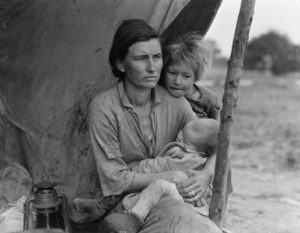Dust Bowl myths put to rest
The great Dust Bowl of the 1930s which saw vast areas of the US prairielands devastated by drought and over-farming was not quite an ‘Okie diaspora’ as portrayed in popular culture, according to new research.
A study of longitudinal data from the US Census records looking at migration patterns of those affected by the Dust Bowl of the 1930s has come up with some startling conclusions which may inform our common preconceptions about migration and contradict fictional portrayals of the era in books, films and music such as ‘Of Mice and Men’ and ‘Dust Bowl Ballads’.
The study by the US National Bureau of Economic Research found that while migration rates were much higher in the Dust Bowl than elsewhere in the US, the difference was due to the fact that individuals who were typically unlikely to move – for instance those with young children or those living in their birth state – were equally likely to move during the Dust Bowl.
“While this result of elevated mobility conforms to long-standing perceptions of the Dust Bowl, our other principal findings contradict conventional wisdom,” researchers Jason Long and Henry Siu said.
Relative to other occupations, farmers in the Dust Bowl were the least likely to move; this relationship between mobility and occupation was unique to that region, the researchers said.
And outward migration rates from the Dust Bowl region were only slightly higher than they were in the 1920s.
“Hence, the depopulation of the Dust Bowl was due largely to a sharp drop in migration inflows. Dust Bowl migrants were no more likely to move to California than migrants from other parts of the US, or those from the same region ten years prior,” the researchers said in the report, titled “Refugees from dust and shrinking land: tracking the dust bowl migrants’.
“In this sense, the westward push from the Dust Bowl to California was unexceptional,” they said.
“Instead, Dust Bowl migrants made relatively local moves, tending to remain in the Dust Bowl affected states.
“Migration from the Dust Bowl was not associated with long-lasting negative labour market effects, and for farmers, the effects were positive,” the researchers said.
The Dust Bowl of the 1930s was one of the greatest environmental and economic catastrophes in US history.
The severity of the event’s environmental degradation, farm failure, and economic dislocation has cemented its place in the mythology of the American experience and it has spawned numerous books, films and songs.
Perhaps the most enduring image of the Dust Bowl is the exodus of destitute farmers and other ‘Okies’ from the Southern Great Plains, one of the most famous episodes of internal migration in American history.
However, little systematic evidence has been brought to bear on even the basic contours of this migration episode.
The Dust Bowl occurred as the confluence of drought, erosion, and economic depression throughout the Great Plains.

Lange took six photographs of Thompson and her family. Despite the photo’s fame, Thompson’s identity remained unknown until 1978
“The drought began in the winter of 1931; throughout most of the 1930s, and especially mid-decade, minimal precipitation, high winds, and pestilence led to widespread crop failure,” the report said.
“While the effects were widespread, matters were most severe in the Southern Plains states of Colorado, Kansas, Oklahoma, and Texas and the out-migration from this region looms largest in the formation of the Dust Bowl narrative.
“Poor seasons were not new to the Plains in the 1930s. Yet in many ways the decade was unprecedented. One fundamental difference from previous droughts was the number of people affected.
“Between 1890 and 1930, the population of the Southern Plains states had increased from 4,496,000 to 11,561,000. In the counties most greatly affected by the Dust Bowl, the population had increased from 14,000 to 121,000. Most striking was the severity of the drought, the worst in over a hundred years of formal meteorological record keeping.
“Dust storms, like the famous Black Sunday storm of April 1935, were also more frequent and damaging. Severe wind erosion and occasional water erosion resulted in widespread loss of topsoil and declining agricultural productivity.
“These problems were exacerbated by the externalities associated with small-scale Plains agriculture, which dis-incentivized farmers from engaging in basic erosion prevention measures.
“The environmental calamity coincided with the U.S. and international Great Depression. Together, these shocks amplified long term structural change in agriculture, due to mechanization and consolidation, and falling agricultural prices since the end of the First World War.
“Prices fell precipitously in the early 1930s, severely impacting farm incomes,” the report said.
The full report can be seen at: http://www.nber.org/papers/w22108












